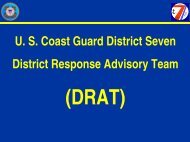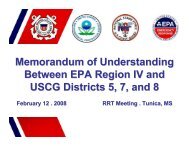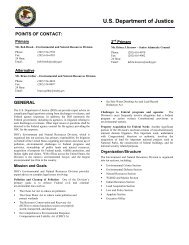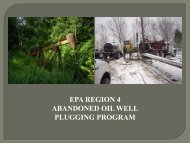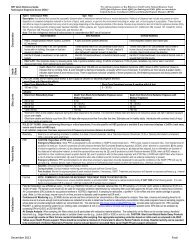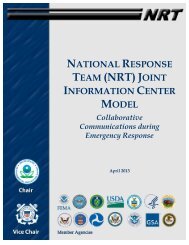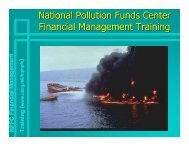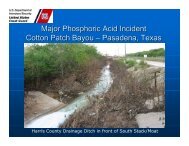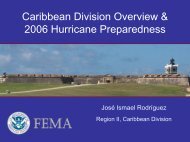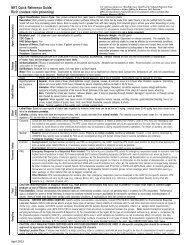a few days or weeks, unmetabolized or metabolized hydrocarbons in zooplankton could be transferred to predators.Geraci (1990) has estimated a forty-ton whale would have to consume approximately 150 gallons on oil to result inharmful effects. Considering the low concentrations and short duration of exposure to dispersed oil, as describedearlier, it is unlikely the listed whales would ingest this volume of oil through consuming contaminated zooplankton.Prey Abundance: Toxicity to ZooplanktonConcerns have been expressed that listed marine species, namely baleen whales, could be adversely affected if majorpopulations of key pelagic or benthic prey species were severely impacted. Though some studies do indicate toxiceffects to zooplankton from dispersed oil, serious population impacts are unlikely at the short-term exposures thatwould result following dispersion in the zones pre-authorized under the Letters of Agreement.When dispersants are applied in pre-authorized deep water to turbulent seas, the resulting oil concentrations in thewater column will remain below levels observed to cause adverse biological effects to zooplankton in laboratorytests. Available toxicological data indicate the range of sublethal and lethal threshold concentrations for mostaquatic organisms is above 10 ppm over an exposure period of 48 to 96 hours. It is unlikely that dispersed oil wouldexceed 10 ppm concentration and 2-4 hour duration at depths below the upper 10 meters of the water column (SEA,1995). Consequently, adverse effects are not expected below the upper 10 meters of the water column following oildispersion. Within 10 meters of the surface, potential exposure of water column organisms to concentrations of 10ppm or higher dispersed oil would be brief, lasting no longer than a few hours. Most of these organisms have theability to rapidly metabolize and completely depurate petroleum hydrocarbons once exposure ceases. Although suchexposures could result in temporary sublethal effects on physiological functions in some planktonic organisms, theexisting data indicate that chronic effects are unlikely (NRC, 1989; SEA, Inc., 1995). The range of sublethal andlethal thresholds measured for modern dispersants in the absence of oil as determined by laboratory tests withsensitive species is much greater than concentrations that occur in the water column following dispersant application(NRC, 1989; Rycroft, et. al., 1994). Considering the broad distribution and relatively short life cycle ofzooplankton, population level effects from such a short-term, pulsed exposure to low concentrations of dispersed oilare not expected and, therefore, unlikely to adversely impact predators such as baleen whales.Emergency AuthorizationAnalysis of AlternativesThe proposed action pre-authorizes the FOSC to use dispersants as a first-stage response technique in specifiedzones as described above. The alternative is to require the FOSC to seek CRRT authorization to use dispersants inthese zones on a case-by-case basis at the time of an oil spill emergency. The limited "window of opportunity" forthe most optimal and effective use of dispersants following an oil spill occurs very early -- usually within the firstfew hours. Without pre-authorization to permit rapid response and mobilization of the necessary equipment, thedelay for case-by-case RRT approval would realistically eliminate dispersants as a response option. Moreover, inthe absence of pre-authorization, spill response organizations are unlikely to invest in the equipment and trainingnecessary to apply dispersants due to the low probability that authorization would be issued in time to employ thetechnique effectively. Pre-authorization enabling timely use of dispersants under appropriate conditions in thedesignated zones provides greater protection for listed species and critical habitat than does case-by-caseauthorization at the time of a spill emergency.Mechanical RemovalMechanical containment and removal will remain the preferred response tool for most oil spills, which usually areclose to shore in areas where other response options are unlikely to be approved. Experience has shown, though,that mechanical response often cannot adequately deal with very large spills offshore. Performance of mechanicalmethods can be severely limited by weather and oceanic conditions and by the nature of the oil slick. Booms andskimmers are of limited use even in moderate seas and are usually effective only at slow currents (less than 1 knot)and low wave heights (less than 2 meters). Consequently, mechanical recovery rates are often poor. Even undercalm conditions, use of mechanical equipment alone to deal with large spills in which oil rapidly spreads over large
areas may not be feasible. For these reasons, dispersant application is an important complementary spill responsetechnique and should be included along with other techniques as on option in developing the appropriate responsestrategy. Under the Letters of Agreement, use of dispersants will be considered when and where physical removal isimpossible or insufficient for protecting natural resources, including listed species.In-Situ BurningIn-situ burning is an oil spill response technique that can quickly remove large volumes of oil from the water surfaceby igniting oil that is towed away from the main slick in fire-resistant boom. Though in-situ burning is a highlyuseful and important response option, there are some differences in the range of oil and weather conditions underwhich in-situ burning and dispersants are effective. For example, in-situ burning is not effective once oil has spreadto less than about two millimeters thick. Also, if winds are blowing shoreward toward populated areas or sensitiveenvironments, in-situ burning is unlikely to be employed due to concerns about potential effects of the smoke plume.Under conditions for which in-situ burning would not be effective or creation of a smoke plume is deemedunacceptable, dispersants may be a viable option.No ActionAnother alternative is not attempting to remove released oil from the water surface, potentially allowing the oil towash ashore. The oiled shoreline could be cleaned or allowed to recover naturally. Due to the importance ofnearshore and shoreline habitat to a variety of organisms and the difficulty of cleaning oiled shorelines withoutinflicting further injury, this alternative is considered the least desirable from several perspectives, includingprotection of listed species and critical habitat. Unrecovered oil poses a high risk of exposure and injury to wildlife,especially sea birds, marine mammals, and intertidal organisms. Cleaning and rehabilitation of oiled wildlife,particularly marine mammals, have had limited success and release of rehabilitated animals creates a risk ofintroducing disease into wild populations.ConclusionsThe purpose of dispersants, used alone or in conjunction with other open-water spill response techniques, is toquickly remove spilled oil from the water surface, thereby reducing exposure to wildlife and preventingcontamination of sensitive nearshore and shoreline habitat. Under appropriate conditions, dispersants can reduceenvironmental impacts from oil spills, including injury to listed species and critical habitat. Dispersant application isnot likely to adversely affect listed species beyond the potential effects of the spilled oil or add to the cumulativeenvironmental stresses currently acting on the species.The parties to these Caribbean Letters of Agreement pre-authorizing dispersants as an oil spill response technique inthe designated zones conclude that this action is not likely to adversely affect the listed species or critical habitatpresent in the area under consideration and that formal consultation under Section 7 of the Endangered Species Actis not necessary. We request that you concur with these conclusions. Consultation will be re-initiated if additionalinformation not previously considered becomes available indicating adverse effects to listed species or criticalhabitat from the identified action.ReferencesAllen, A. A. and R.J. Ferek. 1993. Advantages and disadvantages of burning spilled oil. In Proceedings of the1993 International Oil Spill Conference, March 29 - April 1, 1993, Tampa, Florida, pp. 765-772.Ernst, C.H., J. Lovich, and R.W. Barbour. 1994. Turtles of the United States and Canada. Washington D.C.:Smithsonian Institution Press, pp. 29-102.Fritts, T.H. and M.A. McGehee. 1982. Effects of Petroleum on Development and Survival of Marine TurtleEmbryos. USFWS/OBS-82/37. USDOI, Fish and Wildlife Service, 41 pp.Geraci, J.R. 1990. Physiologic and toxic effects on cetaceans. In Sea Mammals and Oil: Confronting the Risks.



